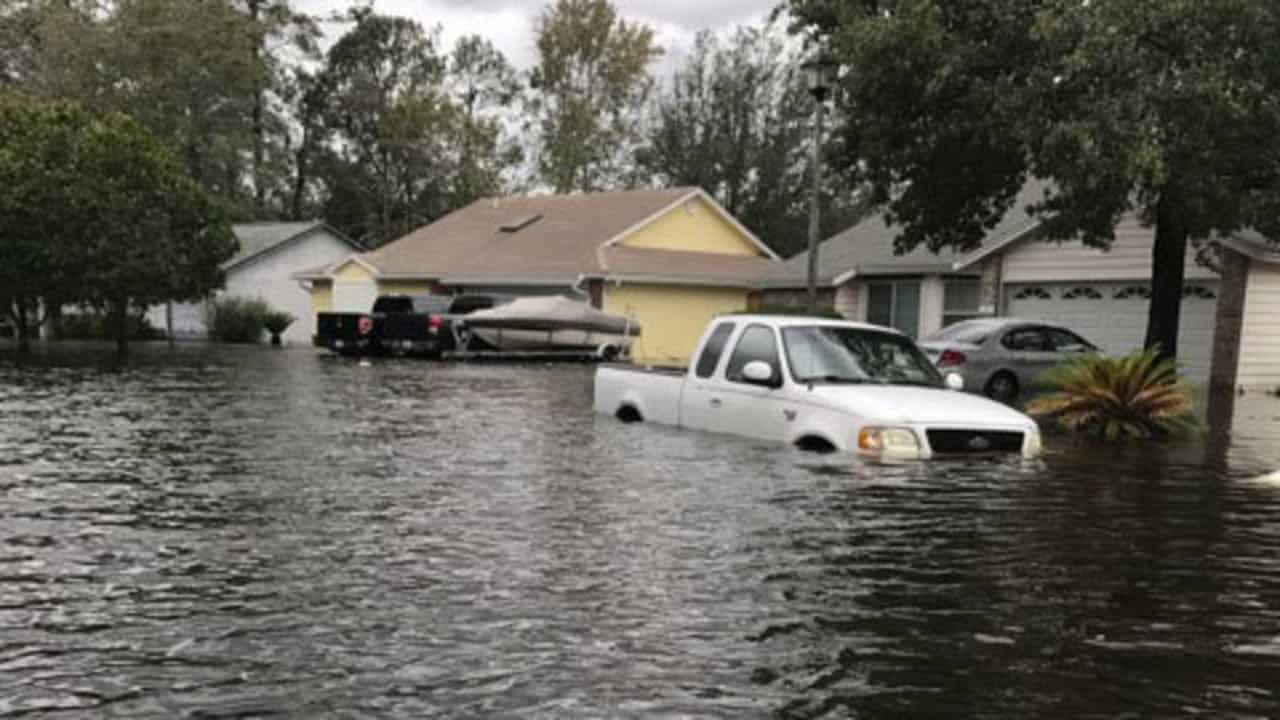When Hurricane Irma swept through the Keys, it took Kathy Reitzel’s home and livelihood with it. Nearly six feet of ocean water flooded her concrete slab two-story home. The storm wiped Fishermen’s Community Hospital, where she worked, off the map. It wasn’t Reitzel’s first flood, however if a state program for hurricane relief works out, it’ll hopefully be her last.
“I just feel like it’s just a matter of time before something like that happens,” she said. “I don’t want to go through something like this again.”
Reitzel wants Florida to purchase her flooded house on Big Pine Key and simply not build another structure there again.

Florida Prefers to Buy Irma-Flooded Homes and Not Rebuild Them
Some communities – North Miami, in particular – have purchased out flood-prone properties previously, however this is the first time the state has managed a program of this size that removes once-valuable real estate from the market. Permanently.
The threat of rising seas in the most vulnerable state in the nation will undoubtedly increase the need for government buyouts – currently a last-resort option that climate adaption managers, conscious of political push back, call “relocation.” Many activists put it more plainly. They call it retreat from land not worthy of cost of saving, or simply beyond saving.
“This is retreat. This is not only an acknowledgment, it’s putting some real money in it,” said South Miami Mayor Philip Stoddard, perhaps the most outspoken climate advocate among South Florida elected officials. “It’s a tip of the hat toward acknowledging reality – that it’s a better idea to have people out of the way than in vulnerable properties.”
Included in a pot of hurricane recovery money from the U.S. Department of Housing and Urban Development topping a billion dollars, Florida reserved $75 million to purchase out flood-damaged homes, with $10 million earmarked for the Keys alone.
The buyout cash is intended to be used “in areas that don’t appear sensible to rebuild,” said Tiffany Vause, spokesperson for Florida’s Department of Economic Opportunity, which is administering the grants. The rest of the $1.8 billion dollar payout primarily covers housing repairs and building and buying new affordable housing.
Interested homeowners have until Aug. 15 to submit an application through their city or county, provided that their community is participating. The application opened July 16, leaving only one month for communities to locate homeowners. The small window discouraged several counties and cities from participating, including Collier and Broward counties and North Miami and Miami. Recovery money for Hurricanes Hermine and Matthew also included cash to purchase homes, but up to now no houses have been acquired via the programs.
The Keys, however, is aggressively pursuing the program, Monroe County’s first for home buyouts.
“We want to take the highest risk structures out of the housing stock,” said Helene Wetherington, Monroe County’s director for disaster recovery. The majority of the applications so far, she said, come from the Lower and Middle Keys, which were hit hard by Hurricane Irma in 2017. Wetherington said Monroe is concentrating on the damaged homes most at risk from sea level rise.
A major target for this program could end up being where Reitzel lives, Big Pine Key – the affordable housing stronghold of the Keys. Residents saw the storm turn their peaceful, cozy neighborhood into a wreck of gnarled metal and homes stripped to the bare wood walls. Repair, even with insurance, is expensive. Too pricey for some residents, who sit on valuable land but don’t have the cash resources to bring their ruined homes all the way up to the new code.
For Reitzel and some of her neighbors, an opportunity to sell their home at full, pre-Irma value and move elsewhere is “a perfect solution.” She’s still living in her house, which now has plywood for counters and a microwave, toaster oven and a hotplate in lieu of a kitchen.
“I hate to leave. It’s sad. The minute I think about it I think ‘oh, why am I doing this?’ and then I remember why,” she said. “Long term, I know I can’t stay on avenue A. It’s too vulnerable.”
She also likes the thought that her home – one that she has loved for the past 20 years – would be razed if purchased. More room for the island’s endangered Key deer, she said.
The program doesn’t necessarily doom future development in other less vulnerable areas of the Keys. The state placed Monroe County under a rate of growth ordinance (ROGO) several years ago, mainly over concerns about safely evacuating the 125-mile-long island chain in advance of a hurricane. ROGO is based on an advanced points system for plots of land and housing, and anyone trying to pull a new building permit has to acquire enough of them to move forward.
The challenge for developers is that there are just so many points to bypass and it can take years to acquire enough of them. In the event the county does buy vulnerable homes and properties like Reitzel’s, the plan is to distribute freed-up ROGO points to possibly allow construction in more appropriate areas. By 2023, when the county estimates it might be out of ROGO points under current growth restrictions, that stash from buyouts “will be VERY important,” said Christine Hurley, Monroe’s assistant county administrator, in an email.
If her sale goes through, Reitzel said she’s finished with the Keys. Her long-term plan is to relocate somewhere hurricanes can’t reach.
Not everyone hoping to get a buyout wishes to retreat so far away. Some hope the money will assist them move from problem homes but remain in the same neighborhood.
In unincorporated Miami-Dade County, Marvin Ramsey’s home has flooded at least every two years since he and his wife first bought their charming bungalow with the big yard near El Portal in 1996. They barely have time between floods to recover from the previous one.
“That leaves us to tread water. It’s just ongoing,” said Ramsey, a 59-year-old retired county employee.
He and his wife love their home, the place they raised their children and grandkids. The place where, on dry weekends, Ramsey cuts his grass and makes lemonade. Nevertheless the repeated floods – with Hurricane Irma as a knockout punch – have made staying there impossible. The Ramseys haven’t had the ability to live in their flood-damaged home since the storm, and they want to sell the house through the state buyout program.
“We were born and raised in South Florida. We love South Florida, and we don’t want to give it up without a real fight,” he said. “This is our last shot. I can’t do any more.”
The family’s issues with repeated floods, some so bad they send schools of minnows darting through Ramsey’s lawn, have been brought to the attention of three separate county administrations for many years. A new flood pump on the street didn’t solve it. No federal or state grant money has ever come through. However this program could possibly be the solution the Ramseys were hoping for, especially since they would like to avoid unloading the situation on an unsuspecting buyer by selling their home.
Miami-Dade County is hoping to buy out homes in areas much like the Ramseys’, places where water naturally used to flow from the Everglades to the sea. In the county, that means Arch Creek, a 3,000-acre swath of low-lying land in Northeast Miami-Dade.
“We’ve learned intuitively you have to go to the drainage basin,” said Jim Murley, Miami-Dade’s chief resilience officer.
In 2016, experts with the Urban Land Institute developed a plan to make the area more resilient to flooding worsened by climate change. The main idea? Buying out homes and returning them to nature. Refer to it as retreat or relocation or something else that doesn’t spook political leaders and real estate investors, experts say the reality of rising seas will almost certainly force communities, and the state, to expand purchase programs like the one the state is providing now.
“We think this is probably the trend of the future,” Murley said.
Buyouts already are an increasingly employed option after natural disasters – especially after Hurricane Sandy hit the Northeast in 2012. They give homeowners a way out of a vulnerable property without passing the chance on to someone else. And they make flood insurance cheaper, too.
“If you can eliminate repetitive flood loss properties, that helps your flood rating, which brings down the cost for flood insurance for everyone in the community,” said Stoddard, the South Miami mayor.
Insuring these flood-prone properties is costly, so much so that the Ramseys couldn’t afford it before Hurricane Irma hit. They cite unaffordable insurance as one of the primary reasons they need to go.
There’s no doubt that a buyout through this program is going to be win for the Ramseys and Kathy Reitzel. They both said the money would help them move somewhere less vulnerable, even though, in the Ramseys’ case, that may mean just up the street.
But land use experts question how practical buyouts are for the community around them, or for the nation, in an effort to adjust to climate change. For starters, it’s going to be expensive and ultimately financially impossible to purchase out every home that will be threatened by rising seas. In Florida alone, there could possibly be 1.5 million homes susceptible to chronic flooding by the end of the century, in accordance with an analysis by Climate Central and Zillow.
Thomas Ruppert, a coastal planning specialist with Florida Sea Grant, called buyouts a short-term strategy for a long-term problem.
“You can view buyouts a lot like beach nourishment. They both represent the current, most politically acceptable response to a problem, but they both kick the can down the road because they don’t address the root cause of the problem,” he said. “It puts the taxpayer on the hook for past bad decisions. And we’re still making those bad decisions.”
Worse, he said, is that offering buyouts now creates the expectation there will be more from now on, which leads people to keep investing in vulnerable spots. It’s like the National Flood Insurance Program, he said. It’s discounted to the point experts say it doesn’t reflect the real danger of the property, and it permits people to keep rebuilding in vulnerable areas.
The long-term solution, Ruppert said, is smarter development, not an eternal dependence on the taxpayer. That means telling developers they can’t build in flood-prone places. It’s not unusual. In Virginia Beach this spring, a judge upheld a town council’s decision to deny a developer’s request to rezone flood-prone land for home development.
However in Florida, where development is the lifeblood of the state and a lot of its new construction is along the coast, it’s an almost unimaginable idea politically.
“We get better and better at how we build but we refuse to acknowledge the problem of where we build,” he said. “When you build at risk or future at risk development, you get to privatize the benefit of the development and you socialize the risk.”
Florida Prefers to Buy Irma-Flooded Homes and Not Rebuild Them
When Hurricane Irma swept through the Keys, it took Kathy Reitzel’s home and livelihood with it. Nearly six feet of ocean water flooded her concrete slab two-story home. The storm wiped Fishermen’s Community Hospital, where she worked, off the map. It wasn’t Reitzel’s first flood, however if a state program for hurricane relief works out, it’ll hopefully be her last.
“I just feel like it’s just a matter of time before something like that happens,” she said. “I don’t want to go through something like this again.”
Reitzel wants Florida to purchase her flooded house on Big Pine Key and simply not build another structure there again.
Some communities – North Miami, in particular – have purchased out flood-prone properties previously, however this is the first time the state has managed a program of this size that removes once-valuable real estate from the market. Permanently.
The threat of rising seas in the most vulnerable state in the nation will undoubtedly increase the need for government buyouts – currently a last-resort option that climate adaption managers, conscious of political push back, call “relocation.” Many activists put it more plainly. They call it retreat from land not worthy of cost of saving, or simply beyond saving.
“This is retreat. This is not only an acknowledgment, it’s putting some real money in it,” said South Miami Mayor Philip Stoddard, perhaps the most outspoken climate advocate among South Florida elected officials. “It’s a tip of the hat toward acknowledging reality – that it’s a better idea to have people out of the way than in vulnerable properties.”
Included in a pot of hurricane recovery money from the U.S. Department of Housing and Urban Development topping a billion dollars, Florida reserved $75 million to purchase out flood-damaged homes, with $10 million earmarked for the Keys alone.
The buyout cash is intended to be used “in areas that don’t appear sensible to rebuild,” said Tiffany Vause, spokesperson for Florida’s Department of Economic Opportunity, which is administering the grants. The rest of the $1.8 billion dollar payout primarily covers housing repairs and building and buying new affordable housing.
Interested homeowners have until Aug. 15 to submit an application through their city or county, provided that their community is participating. The application opened July 16, leaving only one month for communities to locate homeowners. The small window discouraged several counties and cities from participating, including Collier and Broward counties and North Miami and Miami. Recovery money for Hurricanes Hermine and Matthew also included cash to purchase homes, but up to now no houses have been acquired via the programs.
The Keys, however, is aggressively pursuing the program, Monroe County’s first for home buyouts.
“We want to take the highest risk structures out of the housing stock,” said Helene Wetherington, Monroe County’s director for disaster recovery. The majority of the applications so far, she said, come from the Lower and Middle Keys, which were hit hard by Hurricane Irma in 2017. Wetherington said Monroe is concentrating on the damaged homes most at risk from sea level rise.
A major target for this program could end up being where Reitzel lives, Big Pine Key – the affordable housing stronghold of the Keys. Residents saw the storm turn their peaceful, cozy neighborhood into a wreck of gnarled metal and homes stripped to the bare wood walls. Repair, even with insurance, is expensive. Too pricey for some residents, who sit on valuable land but don’t have the cash resources to bring their ruined homes all the way up to the new code.
For Reitzel and some of her neighbors, an opportunity to sell their home at full, pre-Irma value and move elsewhere is “a perfect solution.” She’s still living in her house, which now has plywood for counters and a microwave, toaster oven and a hotplate in lieu of a kitchen.
“I hate to leave. It’s sad. The minute I think about it I think ‘oh, why am I doing this?’ and then I remember why,” she said. “Long term, I know I can’t stay on avenue A. It’s too vulnerable.”
She also likes the thought that her home – one that she has loved for the past 20 years – would be razed if purchased. More room for the island’s endangered Key deer, she said.
The program doesn’t necessarily doom future development in other less vulnerable areas of the Keys. The state placed Monroe County under a rate of growth ordinance (ROGO) several years ago, mainly over concerns about safely evacuating the 125-mile-long island chain in advance of a hurricane. ROGO is based on an advanced points system for plots of land and housing, and anyone trying to pull a new building permit has to acquire enough of them to move forward.
The challenge for developers is that there are just so many points to bypass and it can take years to acquire enough of them. In the event the county does buy vulnerable homes and properties like Reitzel’s, the plan is to distribute freed-up ROGO points to possibly allow construction in more appropriate areas. By 2023, when the county estimates it might be out of ROGO points under current growth restrictions, that stash from buyouts “will be VERY important,” said Christine Hurley, Monroe’s assistant county administrator, in an email.
If her sale goes through, Reitzel said she’s finished with the Keys. Her long-term plan is to relocate somewhere hurricanes can’t reach.
Not everyone hoping to get a buyout wishes to retreat so far away. Some hope the money will assist them move from problem homes but remain in the same neighborhood.
In unincorporated Miami-Dade County, Marvin Ramsey’s home has flooded at least every two years since he and his wife first bought their charming bungalow with the big yard near El Portal in 1996. They barely have time between floods to recover from the previous one.
“That leaves us to tread water. It’s just ongoing,” said Ramsey, a 59-year-old retired county employee.
He and his wife love their home, the place they raised their children and grandkids. The place where, on dry weekends, Ramsey cuts his grass and makes lemonade. Nevertheless the repeated floods – with Hurricane Irma as a knockout punch – have made staying there impossible. The Ramseys haven’t had the ability to live in their flood-damaged home since the storm, and they want to sell the house through the state buyout program.
“We were born and raised in South Florida. We love South Florida, and we don’t want to give it up without a real fight,” he said. “This is our last shot. I can’t do any more.”
The family’s issues with repeated floods, some so bad they send schools of minnows darting through Ramsey’s lawn, have been brought to the attention of three separate county administrations for many years. A new flood pump on the street didn’t solve it. No federal or state grant money has ever come through. However this program could possibly be the solution the Ramseys were hoping for, especially since they would like to avoid unloading the situation on an unsuspecting buyer by selling their home.
Miami-Dade County is hoping to buy out homes in areas much like the Ramseys’, places where water naturally used to flow from the Everglades to the sea. In the county, that means Arch Creek, a 3,000-acre swath of low-lying land in Northeast Miami-Dade.
“We’ve learned intuitively you have to go to the drainage basin,” said Jim Murley, Miami-Dade’s chief resilience officer.
In 2016, experts with the Urban Land Institute developed a plan to make the area more resilient to flooding worsened by climate change. The main idea? Buying out homes and returning them to nature. Refer to it as retreat or relocation or something else that doesn’t spook political leaders and real estate investors, experts say the reality of rising seas will almost certainly force communities, and the state, to expand purchase programs like the one the state is providing now.
“We think this is probably the trend of the future,” Murley said.
Buyouts already are an increasingly employed option after natural disasters – especially after Hurricane Sandy hit the Northeast in 2012. They give homeowners a way out of a vulnerable property without passing the chance on to someone else. And they make flood insurance cheaper, too.
“If you can eliminate repetitive flood loss properties, that helps your flood rating, which brings down the cost for flood insurance for everyone in the community,” said Stoddard, the South Miami mayor.
Insuring these flood-prone properties is costly, so much so that the Ramseys couldn’t afford it before Hurricane Irma hit. They cite unaffordable insurance as one of the primary reasons they need to go.
There’s no doubt that a buyout through this program is going to be win for the Ramseys and Kathy Reitzel. They both said the money would help them move somewhere less vulnerable, even though, in the Ramseys’ case, that may mean just up the street.
But land use experts question how practical buyouts are for the community around them, or for the nation, in an effort to adjust to climate change. For starters, it’s going to be expensive and ultimately financially impossible to purchase out every home that will be threatened by rising seas. In Florida alone, there could possibly be 1.5 million homes susceptible to chronic flooding by the end of the century, in accordance with an analysis by Climate Central and Zillow.
Thomas Ruppert, a coastal planning specialist with Florida Sea Grant, called buyouts a short-term strategy for a long-term problem.
“You can view buyouts a lot like beach nourishment. They both represent the current, most politically acceptable response to a problem, but they both kick the can down the road because they don’t address the root cause of the problem,” he said. “It puts the taxpayer on the hook for past bad decisions. And we’re still making those bad decisions.”
Worse, he said, is that offering buyouts now creates the expectation there will be more from now on, which leads people to keep investing in vulnerable spots. It’s like the National Flood Insurance Program, he said. It’s discounted to the point experts say it doesn’t reflect the real danger of the property, and it permits people to keep rebuilding in vulnerable areas.
The long-term solution, Ruppert said, is smarter development, not an eternal dependence on the taxpayer. That means telling developers they can’t build in flood-prone places. It’s not unusual. In Virginia Beach this spring, a judge upheld a town council’s decision to deny a developer’s request to rezone flood-prone land for home development.
However in Florida, where development is the lifeblood of the state and a lot of its new construction is along the coast, it’s an almost unimaginable idea politically.
“We get better and better at how we build but we refuse to acknowledge the problem of where we build,” he said. “When you build at risk or future at risk development, you get to privatize the benefit of the development and you socialize the risk.”
Have a questions or concern? Nick, Cindy & Nicholas Davis with RE/MAX Premier Group are here to assist you with all your Real Estate Needs. We are always available at 813-300-7116 to answer your questions or you can simply click here and we will be in touch with you shortly.
Need to get started with your mortgage process? You can contact Kyle Edwards with Iberia Bank at 813-495-5131, or simply click here to start your online application.



